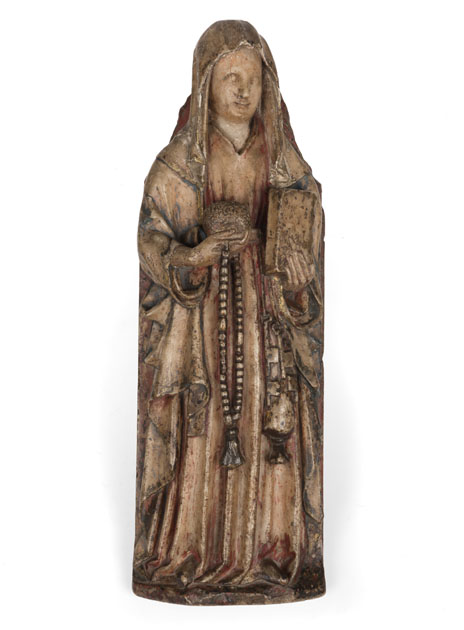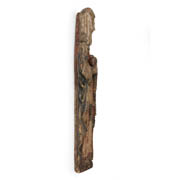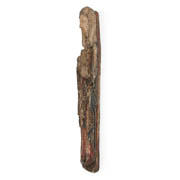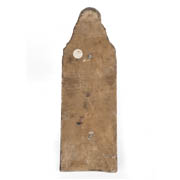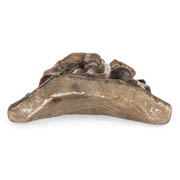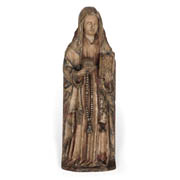Details
- Object type
figure
- Title
St Zita (St Sitha)
- Place Associated
England (place of manufacture)
- Date
15th century
- Materials
alabaster, polychrome, gilt, lead
- Dimensions
overall: 462 mm x 157 mm 4582 g
- Description
-
Alabaster figure of St Zita (Sitha, Cita). A standing figure, veiled and wearing a full-length gown, over which a long mantle falls in drapes below her arms. In her left arm she holds a closed book, and in the right a posy of flowers and a rosary. A purse and keys hang from her girdle. Traces of polychromy remain on much of the figure, with the gown painted red and the mantle blue, with gilding around the edge, white on the veil and flesh tones on the hands and face. The red and black on the background are probably later additions.
Two small holes are drilled into the reverse, which would originally have been set with wire for fixing to a wooden frame or setting. The bottom of the reverse is roughly curved into a three sided-base, the back of which has been hollowed out for ease of lifting. Post-medieval inscriptions on the reverse read SRAKEIL and SPAVLA.
According to her biography, at the age of 12, Zita (circa 1212-1272) went to work as a servant for a rich weaving family, the Fatinellis of Lucca, Italy. She devoted herself to domestic service for the rest of her life, believing her status to have been divinely assigned to her by God. Many of the deeds and miracles attributed to Zita relate to her selfless piety and desire to provide and care for the destitute and hungry of Lucca - often to the annoyance of her masters and fellow servants. One miracle story, alluded to in this alabaster, relates how Zita was angrily challenged by the head of the family for taking bread from the household to distribute amongst the poor. Upon being searched for the smuggled bread, the loaf miraculously turned into a posy of flowers, thus disguising Zita's intentions. Initially mistreated, her diligence and loyalty eventually led to Zita's promotion to head housekeeper, as signified by the keys that hang from her girdle.
Although not officially canonised until 1696, a local cult to Zita developed after her death, which soon spread throughout Europe. Altars, shrines and images were found across Europe and in a particularly astonishing abundance throughout late medieval England.
Zita’s surprising popularity in England may derive from an influx of Lucchese merchants and those associated with the Riccardi Bank of Lucca - bankers to Edward I (1239-1307) from the late thirteenth century. Unlike much of mainland Europe, England did not have its own ‘servant saint’ in the mould of women such as St Notburga of Rottenburg, or St Margaret of Louvain, and it is perhaps this absence of a ‘homegrown’ alternative that allowed Zita’s cult to flourish.
As a patron saint to maids and those in domestic service, Zita provided a humble and sympathetic figure to whom domestic workers, particularly female domestic workers, could identify and pray to in hope of intercession and favour. She could also be called upon to aid with the finding of lost items, especially keys. The survival of illuminations in expensive private prayer books and examples of statuary, stained glass, shrines and altars, dedicated to St Zita, are indicative of a broader community appeal, supported by the patronage of the rich upper classes. She may well have been revered as a suitable role model for women of the noble and middling classes, providing an ideal of household management and devout Christian practice. Elite households may also have been keen to encourage veneration to Zita within their communities and households as an exemplar of obedience, piety and hard work to those in their service.
A similar panel, set within the St Catherine altarpiece, now on display in the Galleria Franchetti alla Ca' d’Oro, Venice, provides an example of how this figure may have originally been presented, within a larger altarpiece scheme.
- Credit Line/Donor
Gifted by Sir William and Lady Burrell to the City of Glasgow, 1944
- Collection
Burrell Collection: Alabasters
- ID Number
1.44
- Location
Burrell Collection
